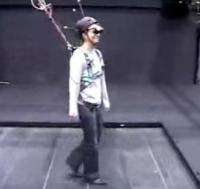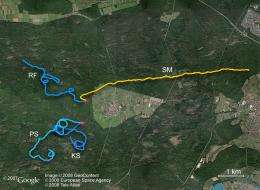Scientists show that people really walk in circles when lost (w/ Video)

(PhysOrg.com) -- Scientists in the Multisensory Perception and Action Group at the Max Planck Institute for Biological Cybernetics in Tübingen, Germany, led by Jan Souman and Marc Ernst, have now presented the first empirical evidence that people really walk in circles when they do not have reliable cues to their walking direction.
Their study, published today in the journal Current Biology, examined the walking trajectories of people who walked for several hours in the Sahara desert (Tunisia) and in the Bienwald forest area (Germany).
The scientists used the global positioning system (GPS) to record these trajectories. The results showed that participants were only able to keep a straight path when the sun or moon was visible. However, as soon as the sun disappeared behind some clouds, people started to walk in circles without even noticing it.
Speaking about the study, Jan Souman said: "One explanation offered in the past for walking in circles is that most people have one leg longer or stronger than the other, which would produce a systematic bias in one direction. To test this explanation, we instructed people to walk straight while blindfolded, thus removing the effects of vision. Most of the participants in the study walked in circles, sometimes in extremely small ones (diameter less than 20 metres)."
However, it turned out that these circles were rarely in a systematic direction. Instead, the same person sometimes veered to the left, sometimes to the right. Walking in circles is therefore not caused by differences in leg length or strength, but more likely the result of increasing uncertainty about where straight ahead is. "Small random errors in the various sensory signals that provide information about walking direction add up over time, making what a person perceives to be straight ahead drift away from the true straight ahead direction," according to Souman.

Marc Ernst, Group Leader at the MPI for Biological Cybernetics, added: "The results from these experiments show that even though people may be convinced that they are walking in a straight line, their perception is not always reliable. Additional, more cognitive, strategies are necessary to really walk in a straight line. People need to use reliable cues for walking direction in their environment, for example a tower or mountain in the distance, or the position of the sun." In future research, Souman and Ernst will focus on how people use these and various other sources of information to guide their walking direction.
For this, the scientists will use state-of-the-art Virtual Reality equipment, including a revolutionary new omnidirectional treadmill ("Cyber-carpet", see video). Participants will try to find their way through a virtual forest, while walking in place on the treadmill and never leaving the laboratory. This will allow the scientists to have much more control over the information available to participants, making it possible to better test specific explanations, for example how people use the position of the sun to orient themselves.
More information: www.cell.com/current-biology/a … 0960-9822(09)01479-1
Source: Max-Planck-Gesellschaft (news : web)




















